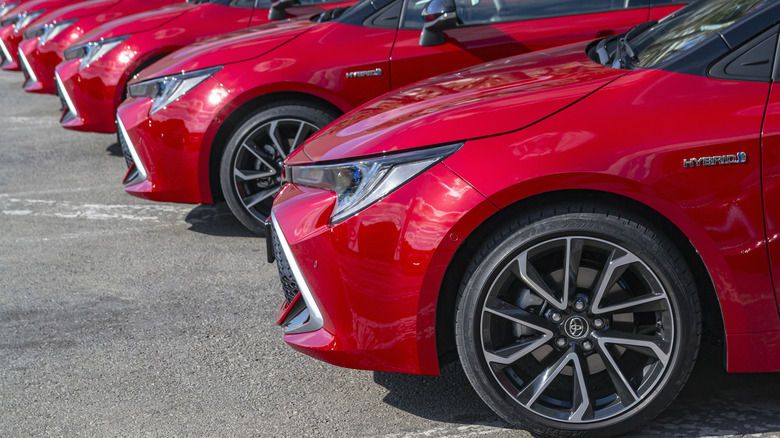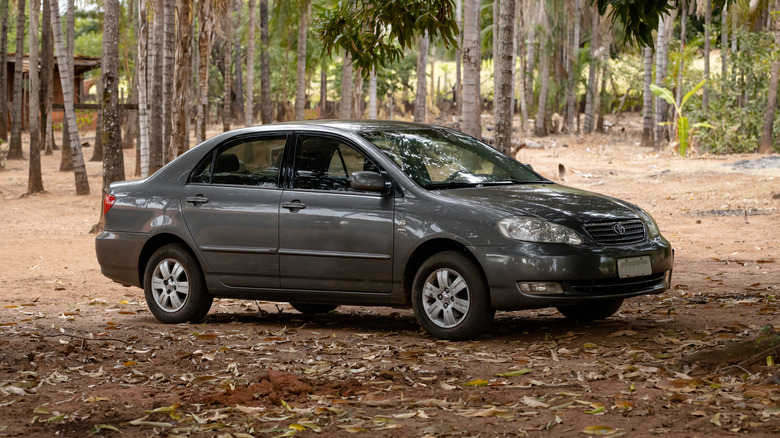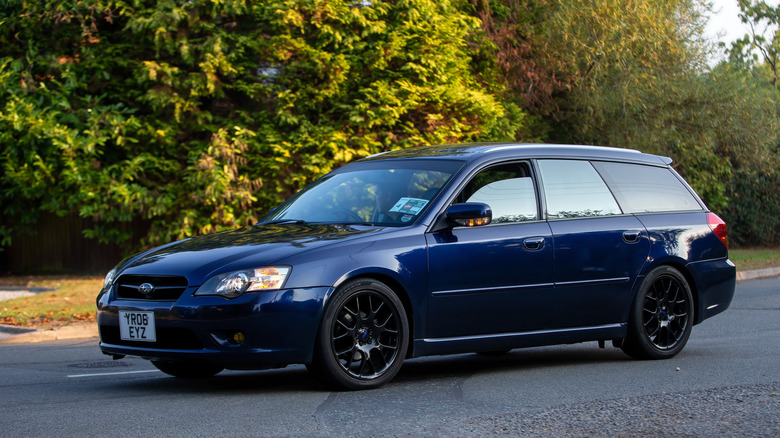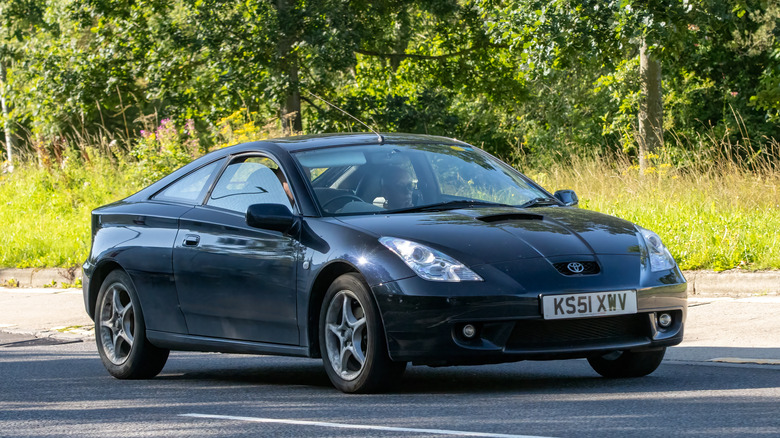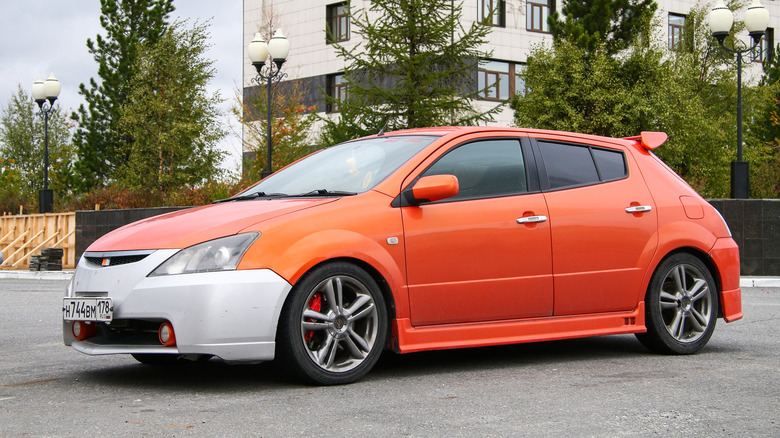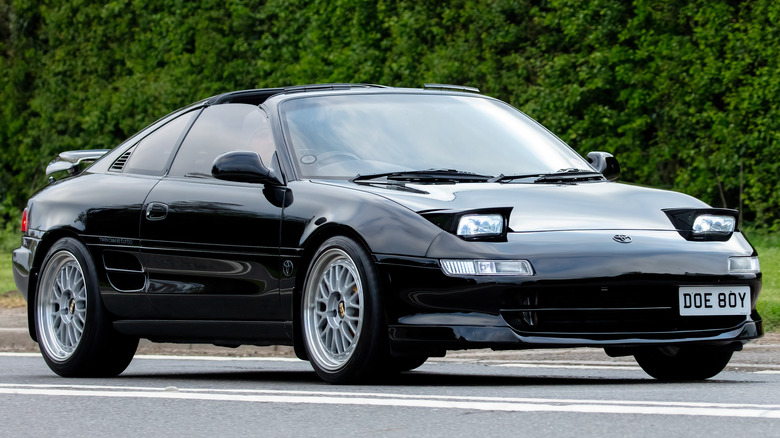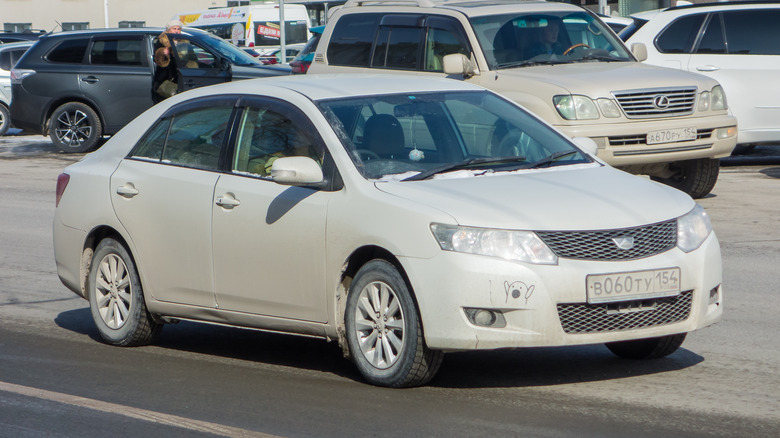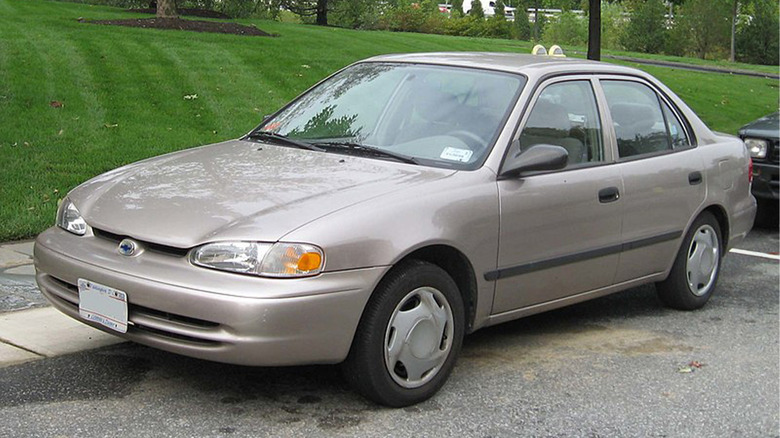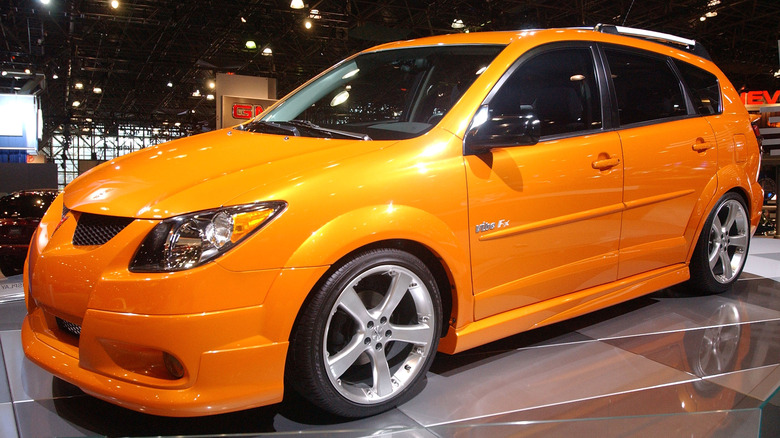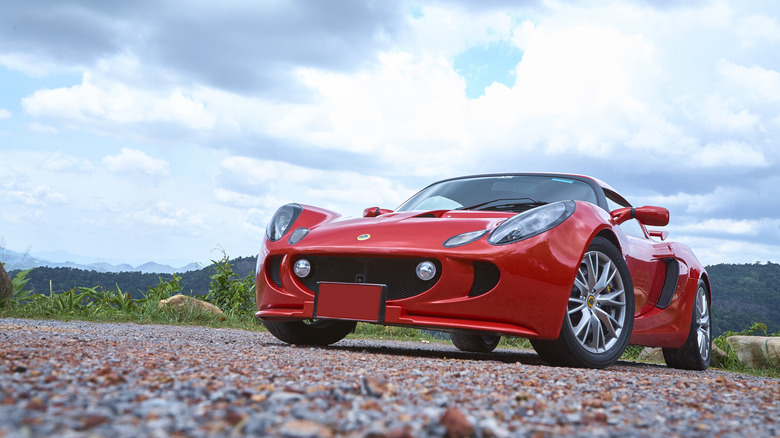Every Toyota Model Powered By The 1ZZ-FE Engine
Toyota is known for making tons of great engines over the years. The brand's reliability, fuel economy, and willingness to experiment with things like hybridization put the Japanese automaker on the map where they have stayed for decades. One such reason for this dominance is the existence of engines like the 1ZZ-FE. The unassuming 1.8-liter engine was part of Honda's lineup for about a decade between 1998 and 2007. Among other things, the engine is known for being able to eclipse 200,000 miles without much of an issue.
In terms of specs, the engine doesn't look like much on paper. The DOHC engine puts out approximately 145 horsepower and 125 pound-feet of torque, although that varied depending on which vehicle it was put into. It did have several new features for its era, including a laser-clad valve seat, a high-pressure die-cast aluminum cylinder block, and continuously variable intake-valve timing. Toyota branded the variable intake valve timing as VVT-i and VVT-L.
There were also three total versions of the 1ZZ-FE. The first was the 1ZZ-FED, which was produced in Japan and was a bit stronger at 148 horsepower and 136 pound-feet of torque. The other was the 1ZZ-FBE. Toyota made the FBE variant for the Brazilian market, and it can run on E100 ethanol. However, neither reached the popularity of the 1ZZ-FE. Millions of cars were sold with the engine, so it was a pretty important one for Toyota.
Here is every car that used the 1ZZ-FE engine.
Toyota Corolla and Matrix XR
The Toyota Corolla is one of Toyota's most important cars, even to this day with the hybrid models. Toyota has sold over 44 million of them to date and climbed from 20 million in sales to 30 million between 1994 and 2005. The brand sold another 1.2 million between 2005 and 2007. That means Toyota sold a metric ton of these cars during the era when they used the 1ZZ-FE engine. It was arguably the most popular car to ever run the engine and there are still hundreds of them available used on dealership lots to this day.
The car was best known for its economy size and price tag while still being relatively nice to drive with a decent number of safety options for its era. It wasn't the fastest car on the planet, but that's not why people bought it. It was as compact then as it is now compared to its contemporaries, which meant that taller folks had trouble fitting into the vehicle. It was still a big seller, though, especially with a sub-$20,000 price tag and its ability to get 30 MPG combined with the five-speed manual transmission.
We bundled this one with the Toyota Matrix XR because it was built on the same platform as the Corolla. It was a hatchback-style car that didn't sell nearly as well as its smaller counterpart. Toyota eventually discontinued the Matrix but came out with the Corolla Cross years later, which is a compact crossover SUV that many say was inspired by the old Matrix.
Toyota Avensis
The Toyota Avensis was a station wagon that Toyota produced from 1997 through 2018 before it was canceled due to lack of demand. It came in two models, the station wagon and the regular sedan. The Avensis also occasionally housed a 1ZZ-FE engine, although it wasn't always available for the car. Many years and models also used the 1AZ-FSE engine, which was similar in size. If you're from the US and you've never heard of the Avensis, it shouldn't come as a surprise. The vehicle was developed and sold entirely for the European market.
In general, the car never saw the level of popularity of some other Toyota models. It was popular in the mid-2000s when it sold over 100,000 units per year from 2004 through 2007. After that, the model saw a steep decline that inevitably led to its demise at the end of the 2010s. Toyota would replace it in the lineup with the European return of the Toyota Camry. The final generation of the Avensis started in 2015, and people simply weren't happy with it.
In general, the car was okay. Reviewers noted a firm ride and noisy engine, especially if owners got the gas engine instead of the available diesel. The safety suite was impressive with standard features that were pretty good for their day, like a car alarm and deadlocks. Plus, the wagon option gave owners a little more cargo room than a standard sedan. It was fine for its era, but there's a reason it became phased out for the more popular Camry.
Toyota Celica
The Toyota Celica was one of Toyota's coolest-looking cars. Even for its era, it had a forward-thinking design that wouldn't look out of place today with only a couple of minor tweaks. Toyota sold the car for 36 years between 1970 and 2006 and the car was discontinued right at the end of the 1ZZ-FE's run as an engine. Despite its sporty demeanor and reputation, it shared the same powerplant as the more economy-focused Corolla. The Celica did get a more powerful 145 horsepower variant of the 1ZZ-FE while the Corolla's version only had about 125 horsepower.
Toyota's history with the Celica is interesting. The car sold more than 50,000 units per year up through 1991 with some model years in the 1980s seeing over 100,000 sales per year. Then, for some reason, Celica sales tanked in the mid and late 1990s before a short revival in the early 2000s. By 2005's discontinuation announcement, the Celica was selling less than 5,000 units per year. According to some, younger people were moving away from sports cars in general. The Celica was collateral damage.
Despite its lack of popularity in its later years, the Celica actually reviewed quite well. Reviewers praised its interior and exterior styling, the reliable performance of the 1.8-liter 1ZZ-FE, and Toyota's knack for build quality. There wasn't really much wrong with the Celica. People were just starting to get into larger vehicles the Honda CR-V, which sold like hotcakes in the early '00s.
Toyota Caldina, Vista, Wish, and Premio
The Toyota Caldina, Vista, Wish, and Premio are four cars that US readers may not be familiar with. All four of these vehicles were made specifically for the Asian market where they were primarily sold. The Caldina was introduced in 1992 and discontinued in 2007. The Vista was made between 1985 and discontinued in 2003. Toyota introduced the Wish in 2003 and eventually discontinued it in 2017. Finally, Toyota introduced the Premio in 2001 and still sells in Japan to this day. All four cars used the 1ZZ-FE engine at some point in their production history.
The Caldina, Premio, and Wish were all either sedans or station wagons, which explains why they got the small 1ZZ-FE. Toyota's Wish is the odd one out since it's a compact minivan, also known as an MPV. For the Wish, its first generation saw the 1ZZ-FE while Vista and the Premio had the engine in 1998. The Caldina received the engine a bit later in life around 2005. Since all four vehicles were smaller, the 1ZZ-FE was more than enough grunt to get them up to speed. You're not likely to find these on dealership lots, however, unless you live in Asia.
Among the four vehicles, the Toyota Wish was arguably the most unique. It was capable of comfortably carrying up to six passengers plus luggage, which it did with little complaint although the legroom wasn't always the best. The Toyota Vista was essentially a Toyota Camry rebadged for a different market, so it made sense when it was put to bed, especially with the Premio already filling that slot until its discontinuation in 2021. The Caldina was also discontinued Toyota's other offerings replaced it.
Toyota Opa, WiLL VS, and Isis
The Toyota Opa, WiLL VS, and Isis were three more cars in the lineup that featured the 1ZZ-FE engine at some point. Toyota's Opa was a five-door hatchback based on the same platform as the Toyota Vista, named after a common exclamation denoting surprise in Portuguese. The Isis was a minivan aimed specifically at the Japanese market and its most unique feature was the doors opening in a panoramic way, creating a massive opening to fit people and cargo. Finally, the WiLL VS was branded to excite younger customers and was a little five-door hatchback.
The cars have very little in common outside of their usage of the 1ZZ-FE engine. Perhaps the most unique car of the three is the WiLL VS, which featured an interesting circular center stack and included G-Book, Toyota's telematics and cell phone linking service. It was reportedly popular in Japan but didn't catch on in the rest of the world. Of the three, the Toyota Opa is arguably the most pedestrian. It was a hatchback that lived from 2000 to 2005, and it wasn't particularly popular or successful.
Toyota doesn't make any of these vehicles anymore for varying reasons. The aforementioned Opa simply wasn't very popular while the WiLL VS wasn't sold outside of Japan. Meanwhile, the unfortunately named Isis lived a fairly long life before it was eventually discontinued as well. None of these vehicles ever took off, but they were all part of Toyota's 1ZZ-FE lineup at some point.
Toyota MR2 and MR-S
The Toyota MR2 isn't one of Toyota's most popular nameplates but it's found a home as an underrated enthusiast car from Toyota. It was a mid-engine car, which is a rarity these days, and Toyota designed it using a variety of other parts from cars from the lineup. In terms of passenger space, it's about the size of a Mazda Miata, so it's mostly for two people to enjoy the road. It also featured disc brakes, pop-up lights, and, at one point in its life, the 1ZZ-FE engine. MR2 stands for "midship runabout two-seater," but was often referred to as Mister Two.
Despite being a fun little car, Toyota didn't sell a whole lot of them. Interest tanked in the '90s, with Toyota only producing a few thousand a year by the mid to late 1990s. Toyota ultimately discontinued the car in 2007 but not before it released the MR2 Spyder, which was the variant with the 1ZZ-FE engine. The MR-S — which was essentially an MR2 designed for the Japanese market — also carried the engine and was featured in Gran Turismo.
The 1ZZ-FE variant of the MR2 wasn't the fastest available model. That distinction went to the variants that housed the 2.2-liter inline-four. It came with a turbocharger and produced 200 horsepower and 200 pound-feet of torque. With its small stature and unique mid-engine design, it's no small wonder that fans want Toyota to bring the car back from the graveyard. Rumor has it that Toyota is considering such a revival although no concrete details are available as of this writing.
Toyota Allion
The Toyota Allion is another car in Toyota's lineup that once carried the 1ZZ-FE engine. It's a twin to the Toyota Premio and was sold exclusively in the Japanese market from 2001 until its discontinuation after the 2020 model year. It replaced the Toyota Carina which had existed since 1970. The Premio and Allion were also mechanically similar to the Toyota Avensis, so it's not terribly shocking that all three models used the same engine at one point.
It was only the first generation of the Allion that saw the 1.8-liter 1ZZ-FE. It was the middle engine option between the 1.5-liter and 2.0-liter options available and Toyota mated it to a four-speed transmission. Shoppers praised it for its easy-to-drive demeanor and comfortable ride quality, although the car had a tendency to feel a tad floaty at higher speeds. It also had decent fuel economy and a comfortable interior. In terms of performance, it had one of the more pedestrian 1ZZ-FE engines, so it wouldn't blow your socks off. It was just a chill, reliable car.
Toyota discontinued this car and the Premio because it shared the same space as the Toyota Camry, which was also discontinued in Japan in 2023. All three cars were replaced with the Toyota Crown in Japan, which the Japanese automaker launched in 2023. It's a hybrid sedan that boasts a lot of the benefits of more modern cars, such as great fuel economy and aggressive styling.
Chevy Prizm
Toyota farmed out the 1ZZ-FE engines to other automakers for use in cars. One such example is the Chevy Prizm, also known as the Geo Prizm. This four-door sedan was initially made as an affordable small car and GM eventually spun off Geo as its own subsidiary to help market its cars to a younger audience. The Prizm was created as a direct partnership between Toyota and GM with Toyota supplying the engine and a few other parts of the vehicle. Despite the same name, the Geo Prizm and Chevy Prizm were, in fact, two separate cars, and only the Chevy variant carried the 1ZZ-FE engine.
In terms of comfort and performance, it shares a lot with the Toyota Corolla. In fact, reviewers often pointed out that the car was essentially a reskinned Toyota Corolla and that the two shared many of the same driving characteristics. The base models were fairly spartan with prices to match. However, enthusiastic buyers could add things like aluminum wheels and extra items via the premium packages to make the car a bit more than a basic daily driver. However, it also upped the price.
Ultimately, Chevy did away with the Prizm and GM eventually discontinued Geo as a brand, thus retiring the Prizm name. The reasons vary, but the major ones were that Geo didn't have any dedicated dealerships, people choosing Chevy's Malibu or Cavalier instead, and waning support from GM's brass.
[Featured image by IFCAR via Wikimedia Commons | Cropped and scaled | All Rights Released]
Pontiac Vibe
The Pontiac Vibe is another car that was the result of the same GM and Toyota partnership that spawned the Chevy Prizm. Thus, it should come as no surprise that the compact crossover came with the 1ZZ-FE engine during its lifetime. GM released it under the Pontiac badge from 2002 through the 2010 model year before it was discontinued. It used the 1ZZ-FE engine for most of its life. The Vibe was discontinued as part of GM's restructuring efforts during its 2009 bankruptcy that saw Pontiac cease to exist as a brand.
The Vibe was actually a pretty decent vehicle from GM. Reviewers praised its comfortable ride, unique features, and the car's roominess. The boxy roofline allowed for excellent second-row headroom and decent storage space, which made it appealing to some folks. Consumers enjoyed the car's fuel economy and general reliability. Some folks even went on to buy a Toyota Matrix since the Matrix and Vibe were built together by GM and Toyota and were mechanically similar the same way as the Corolla and Prizm.
The Pontiac Vibe had a bit of a cult following. Both of its engines proved reliable over the long term, the car came with optional all-wheel drive, and despite being the size of a hatchback, you could fold the seats down like a crossover to get more storage space. It's easy to see why people liked it.
Lotus Elise
We saved the best for last here because of all the cars you'd expect a 1.8-liter inline four-cylinder engine, the Lotus Elise is likely at the bottom of most lists. However, the 1ZZ-FE was used arguably to its greatest effect in the Elise during the 2000s. It doesn't seem like a car equipped with such an engine could feel like a sports car, but the Elise did. It was mostly aided by the fact that the Elise weighed less than 2,000 pounds, allowing the smaller engine to really propel the Elise down straightaways and through corners.
All told, there are two versions of the Elise out there. One with a supercharger and one without. The one without the supercharger could do 134 horsepower and 127 pound-feet of torque. With a supercharger, it upped the horses to 218. At its peak, it could do zero to 60 mph in 4.4 seconds, zero to 100 mph in 10.7 seconds, and accelerate to a maximum of 150 mph — not bad for a car that houses the same engine as a Toyota Corolla. Later models would get a revised version of the engine, dubbed the Toyota 2ZZ-GE, which would give it 160 horsepower stock, a sizable increase from the 1ZZ-FE.
Eventually, Lotus moved on from the Toyota engine, but not before proving that the 1ZZ-FE could be used in a sports car. Reviewers praised the car for its outstanding handling, swift demeanor, and modern amenities like air conditioning and electric windows. It was a pretty impressive car, considering how light it was.
